Click on this link to view the interactive PDF
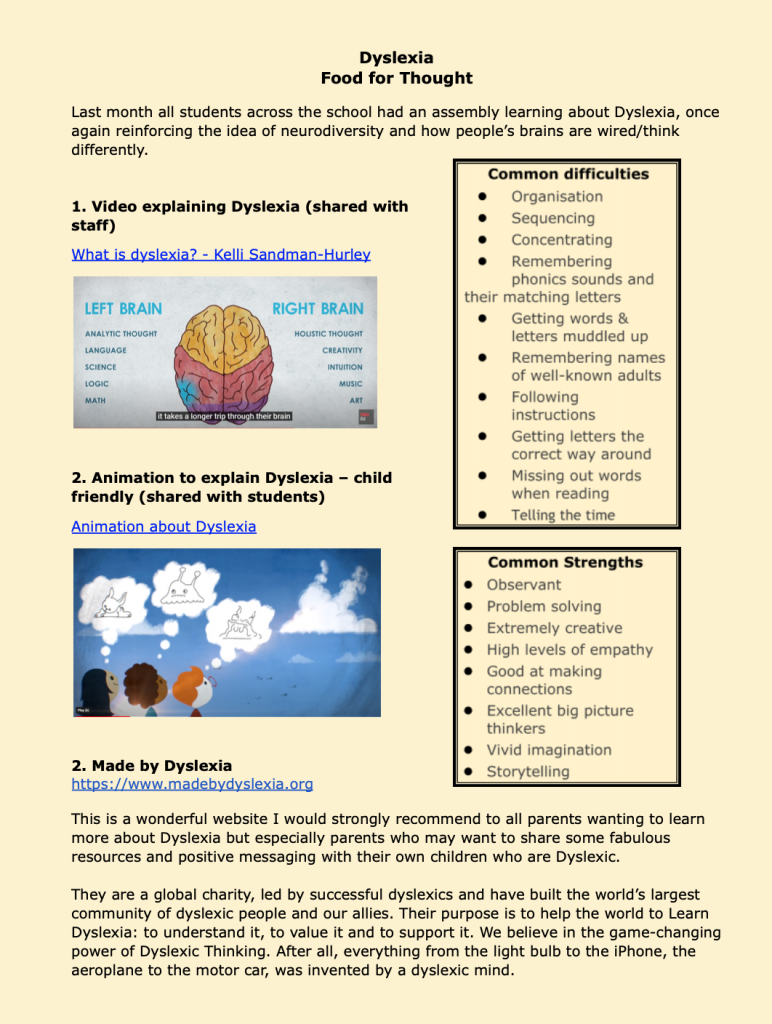
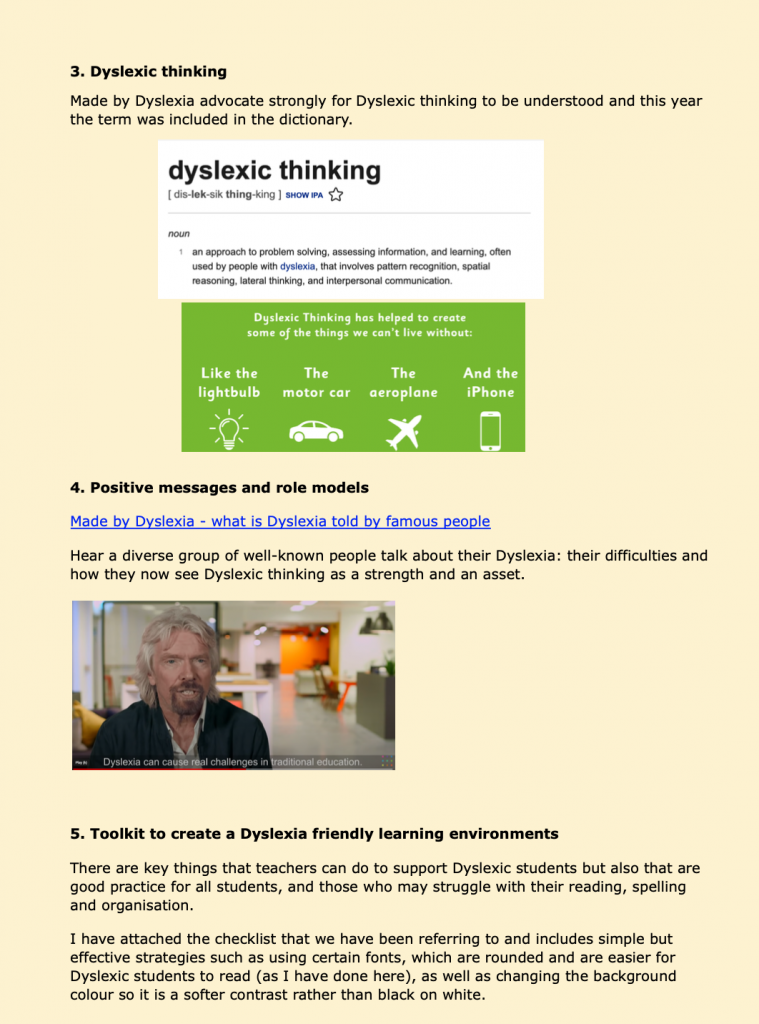
Try this link for older students where you can sign up for free https://www.mindomo.com/ or to create simple to more complex ones for all students: https://www.canva.com/graphic-organizers/templates/
Pupils with dyslexia also have skills such as a strong memory for stories, a wonderful imagination, great spatial reasoning and can think outside the box! You can find more details at Dyslexia Help.
Read the latest Gesher Gazette below! Please click on the link below to view the video links.
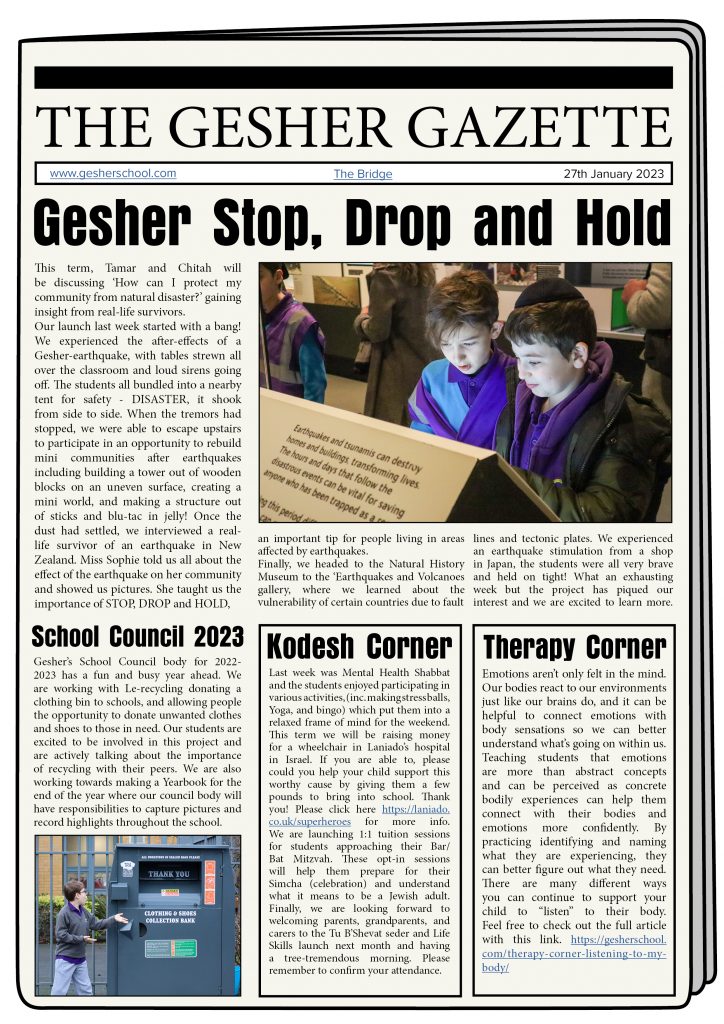
Click on the link below to view the latest Gesher Gazette:
Emotions aren’t only felt in the mind. Our bodies react to our environments just like our brains do, and it can be helpful to connect emotions with body sensations so we can better understand what’s going on within us.
What is Sensation?
Sensation refers to the process in which information is taken and interpreted by the human brain. In order to take in information, the human body is equipped with five senses, which we are taught from childhood: sight, smell, taste, touch, and hearing. Even from a young age, we know to “use our senses” to investigate, enjoy and experience the world around us.
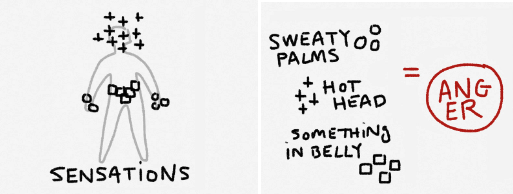
What is Feeling?
Feelings can be understood as mental experiences of body states. Feelings can be of such diversity ranging from love, happiness, contentment to anger, bitterness and even rage. They alert us as to how we feel. If a person is feeling depressed, this feeling makes us aware of our situation. Feelings are connected to so many aspects such as our emotions, thoughts, moods and even sensations. Psychologists believe that feelings are often very subjective. They can be influenced by the memories, personal experiences, and beliefs that people have.
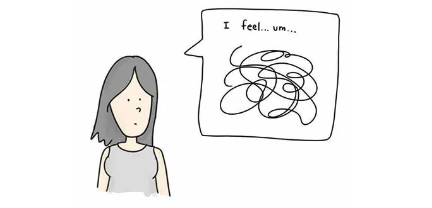
Learning How to Connect Emotions and Body Sensations
By teaching students that emotions are more than abstract concepts and can be perceived as concrete bodily experience, it can help them connect with their body and emotions more confidently. By practising identifying and naming what they are experiencing, they can better figure out what they need.
Below are a few strategies and activities intended on helping children develop an awareness of what their bodies are telling them. A list of sensations and feeling words is also provided below to give students the language to describe what they are experiencing.
I recommend reading the book with your child: Listening to my body: A brief guide to understanding the connection between sensations and feelings by Gabi Garcia, from which some of the information and inspiration in this article is taken.
1) There are many different ways you can continue to support your child to “listen” to their body. You can:
2) Body scan intervention:
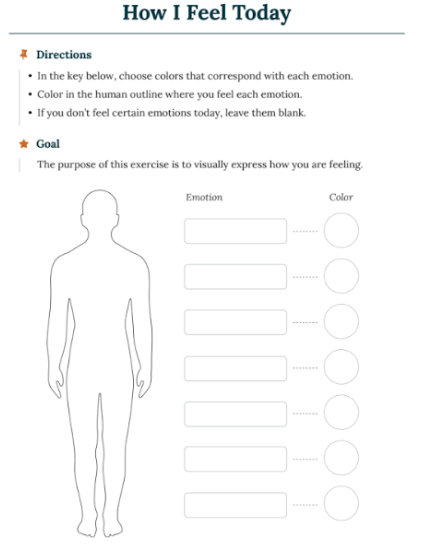
3) Below are a list of sensations that may be helpful to practise identifying and naming what they are experiencing:
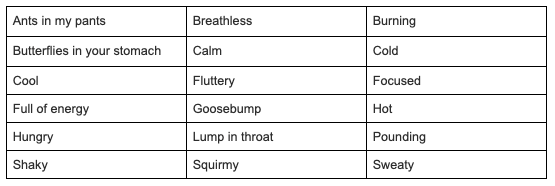
4) Below are a list of feeling words that may be helpful to practise identifying and naming what they are experiencing:


References:
Books:
Websites:
What are Emotions, Feelings and Sensations? Composite or Hierarchical models? (https://emotionallyvague.wordpress.com/2014/10/23/what-are-emotions-feelings-and-sensations-composite-or-hierarchical-models/)
100 Art Therapy Ideas and Prompts (https://www.alternativetomeds.com/blog/art-therapy-ideas/)
Learning How to Connect Emotions and Body Sensations (https://www.hope-wellness.com/blog/learning-how-to-connect-emotions-and-body-sensations)
Difference Between Sensation and Feeling (https://www.differencebetween.com/difference-between-sensation-and-vs-feeling/)
Read the latest Gesher Gazette below! Please click on the link below to view the video links.
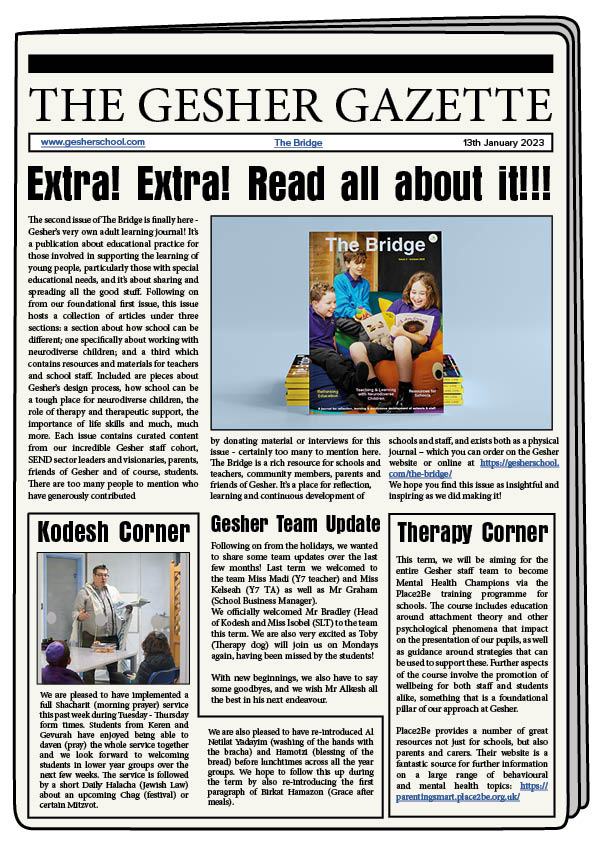
Click on the link below to view the latest Gesher Gazette:
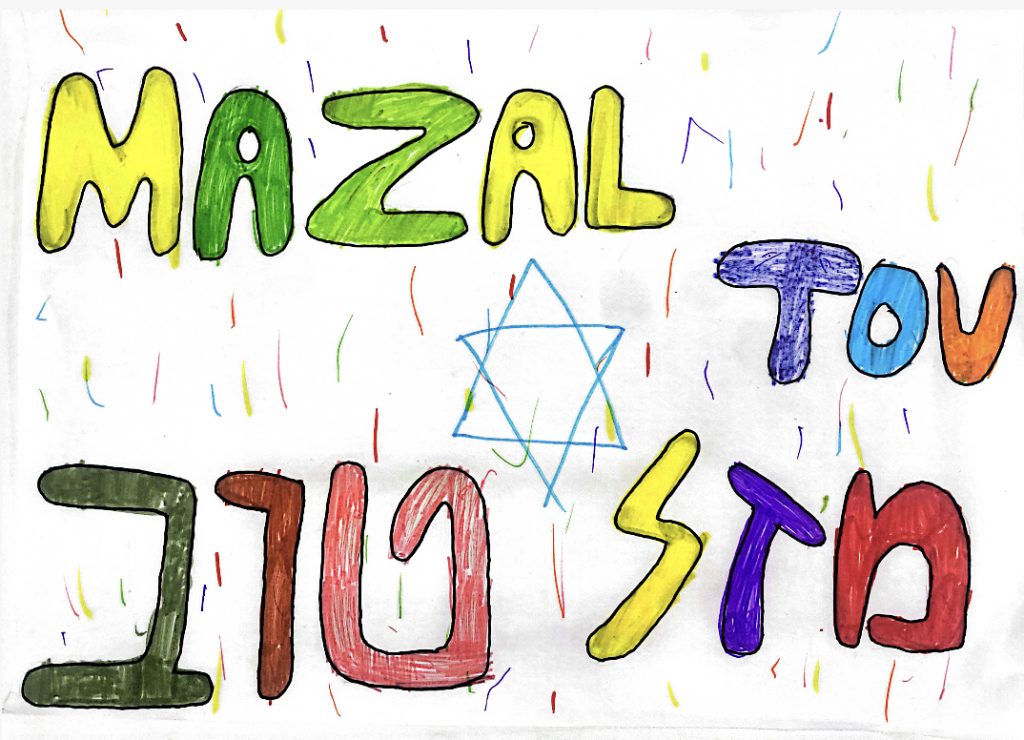 Last year was an enormously busy year for us at Gesher and for our community as a whole. As we start 2023 and reflect on the achievements of 2022 there are two members of the Gesher community we would like to extend a special congratulations to. Firstly, Rama Venchard, our Chair of Governors, who received an MBE in King Charles II’s first New Years Honours List for his services to education. And secondly, Chief Rabbi Ephraim Mirvis, who has received a knighthood in recognition of his interfaith initiatives, work with the Jewish community, and involvement in education programmes, of which we at Gesher have been lucky enough to be a part of. Mazal tov from Gesher!
Last year was an enormously busy year for us at Gesher and for our community as a whole. As we start 2023 and reflect on the achievements of 2022 there are two members of the Gesher community we would like to extend a special congratulations to. Firstly, Rama Venchard, our Chair of Governors, who received an MBE in King Charles II’s first New Years Honours List for his services to education. And secondly, Chief Rabbi Ephraim Mirvis, who has received a knighthood in recognition of his interfaith initiatives, work with the Jewish community, and involvement in education programmes, of which we at Gesher have been lucky enough to be a part of. Mazal tov from Gesher!
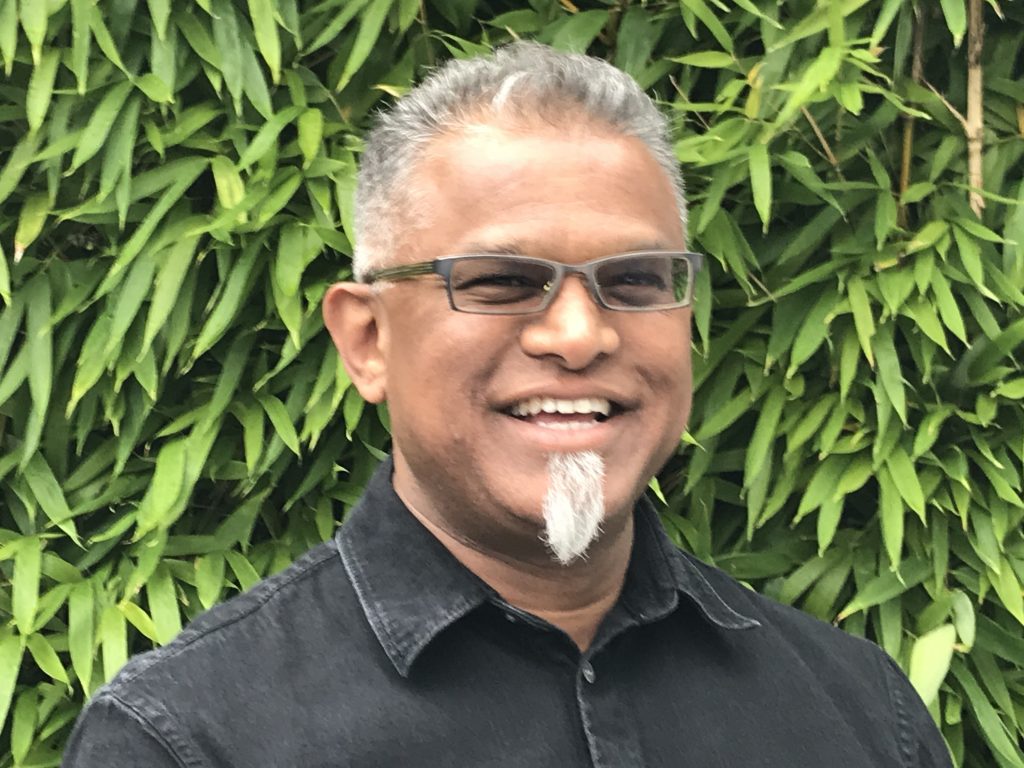
Rama Venchard MBE, Gesher Chair of Governors
Read the latest Gesher Gazette below! Please click on the link below to view the video links.
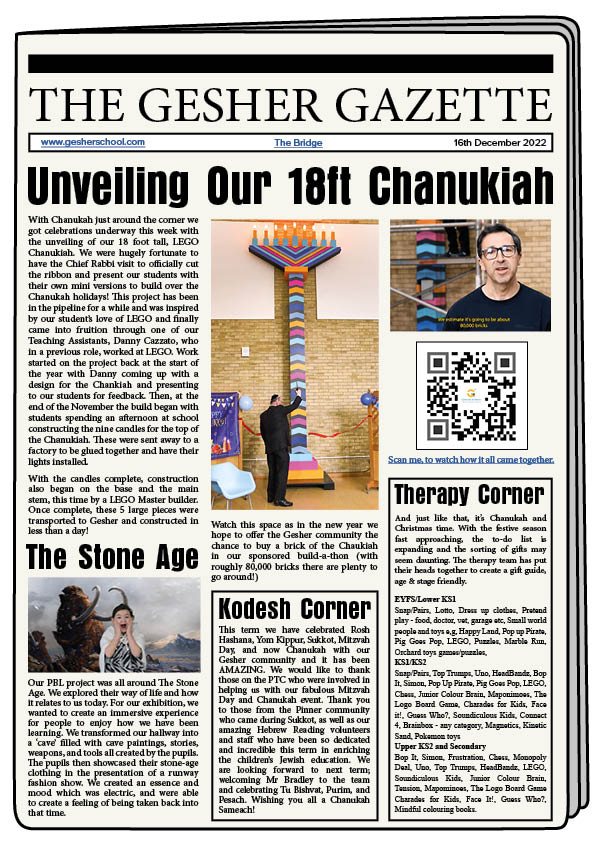
Click on the link below to view the latest Gesher Gazette:
Ask most people to draw a house and nine times out of ten the house they imagine will be a square box, with four square windows, a pitched roof with a chimney, and often some smoke curling into the sky.
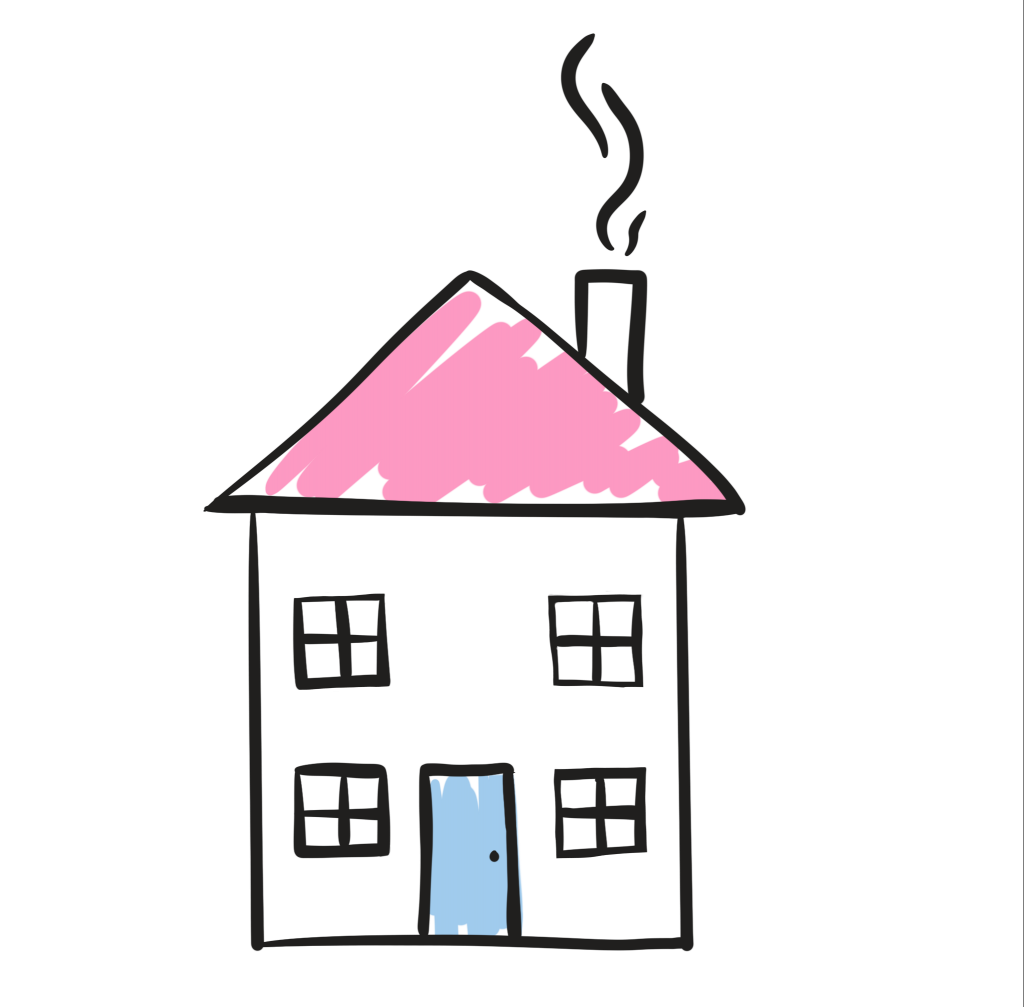
We share a mental model — a blueprint — for what a house is and should look like. We don’t stop to wonder:
Our shared ideas about schools are fixed in much the same way.
There are variations, but our mental model for school tends to include classrooms, corridors, rows of desks, students grouped according to age, one-hour lessons, subject teaching, tests, and so on. This model is based on schools designed in the past. We don’t stop to question whether the school, which we are after all drawing in the C21, should be — needs to be — very different from the blueprint created decades ago. We might ask:
… and so on.
Designing a new school for real is a chance to ask questions like these, and to ensure that the new school is more than just an improvement on the existing model.
“Gesher undertook a serious school (re)design process that placed the needs of their students at the heart of decisions about their new school design.”
At Gesher School, staff, students and parents know how badly a change to the model is needed because most of Gesher’s learners have struggled in schools like the one most of us would draw. So, Gesher undertook a serious school (re)design process that placed the needs of their students at the heart of decisions about their new school design.
Gesher was transitioning from a highly successful primary school to becoming an all-through learning community and needed to find a new school building and facilities, recruit staff, create a secondary school curriculum and reframe its mission and identity.
The leaders of Gesher School knew they needed to go way beyond improvements on the existing model, to design a whole new way of thinking about and doing school, in ways that learned from and built on their experience with primary-age children. They asked:
How might we design an all-through school that will offer success, enhanced self-esteem, personal efficacy, and progression opportunities for all our young people?
Secondly, in doing so, how can we involve multiple stakeholders in our design process?
Thirdly, how might we stand on the shoulders of existing practices around the world?
The design process that Gesher School entered into comprised eight workshops, each involving different stakeholders, which resulted in a school blueprint for:
Upwards of 100 school staff, parents, students, community members, and other local stakeholders contributed to this seriously intentional and inclusive school design process.
Each issue of The Bridge will address an aspect of Gesher’s school redesign process. This issue focuses on the first two of the eight school design workshops that Gesher School undertook, which concerned (i) purpose and (ii) design principles.
(i) Purpose
Gesher’s discussions about purpose started with identifying their ‘non-negotiables’. Non-negotiables tell everyone what is and is not on the table; what is and is not within the scope of the school design team to change. Examples might be ‘no selection by ability’ or ‘the school will be co-education’ or, in Gesher’s case:
These clear non-negotiables influenced design features relating to Special Educational Needs and Disabilities (SEND) provision, to faith observance and understanding, and to the design of curriculum and pedagogy.
A further key defining issue for Gesher to articulate was purpose – the vision and outcomes to which the school community would aspire. Being clear about what the school had to achieve with and for students; about the purpose of learning; about what matters for the community of the school — staff, students and parents – was an essential bedrock of the design process.
Within the current system, aiming for good examination outcomes is a given, and if that was all that mattered, then job done. However, during the workshop, through extensive discussion – and many post-its – it became clear that exam success on its own was not nearly enough. In brief, the outcomes Gesher agreed are that young people should become:
These, one might hope, could be purposes shared by most if not all schools, but two things qualify them as exceptional in Gesher’s context. The first is the inclusiveness of the intent. They are purposes for all students, regardless of their prior educational history or unique needs. The second is to remember that Gesher is a school for children with identified SEND needs, most of whom have been unable to thrive in mainstream schools.

“Staff engaged with mini-case studies of interesting and successful schools around the world to draw from them the particular design features that inspired them.”
(ii) Design Principles
Workshop two was exclusively concerned with design principles and involved staff at the school considering the question: What would be the design principles or features of a school that can confidently achieve these outcomes for all its learners?
Staff engaged with mini-case studies of interesting and successful schools around the world to draw from them the particular design features that inspired them. They used this as a basis to shape their own, then tested the resulting principles they created together using personas of children at Gesher, asking: Would this work and how would it work for Amy or Peter?
Next Time — Curriculum, Pedagogy and Assessment
Agreement on these three components — the non-negotiables, purposes and design principles — precedes work on designing the more practical features of a school. Clear purposes provide a constant reminder of exactly what we aspire to achieve with and for learners and their families. Design principles provide the guiding architecture that relates to these purposes. They are ‘laws with leeway’ that frame what we do and how we do it. They are also the features that unify and inspire those who work in a school, and they guide and discipline decision-making.
With these three in place, the design process moves to consideration of the curriculum, pedagogy and assessment practices that will be informed by and consistent with the design principles and which will enable every student to achieve the outcome ambitions. That is for next time.
In America, there is a long tradition of creating new school designs. Some of the most successful schools in the world have been created in this way – Expeditionary Learning schools; High Tech High (some of whose resources we share later); Big Picture Learning schools; New Tech Network are all examples. The Gates Foundation alone funded more than 2,500 ‘small school models’ across the United States, and New York alone has 200.
Not all of these new school models have been equally successful, of course. However, their students consistently outperform their peers in conventionally sized and structured high schools with comparable demographics. There are some common design features across the majority of these models — and they are very different from the conventional UK school — they all:
The Cost of Not Having New Models in the UK…
Not to foster innovation in school design means that we constantly focus on striving to improve the existing school model – a model more than 100 years old and out of date.
It is a model with multiple features crying out for redesign. For example, it has failed to achieve equitable outcomes, or to address socio-economic challenges, or to engage disengaged learners — or to fully engage most learners, for that matter. Nor has it provided teachers with an intellectually challenging profession, or excited and involved parents around the experience of their children.
Professional Prompt Questions
The design process described above is effective applied to existing schools as well as new ones — revisiting purposes and design features together as a prelude to reviewing wider practices. Might this have value for your school?
The review detailed above distilled six clear outcomes that Gesher is committed to evidencing for all learners. Does your school have similar clarity about its purposes?

Paul Ramsbottom OBE is Chief Executive of The Wolfson Foundation, an independent grant-making charity, funding programmes and activities throughout the UK. The Foundation’s fundamental aim is to improve the civic health of society, mainly through education and research. He is also the Chief Executive of a linked charity, the Wolfson Family Charitable Trust.
Gesher School was delighted to receive a grant from the Wolfson Family Charitable Trust in 2021 to adapt and equip a Maker Space in our building. We value enormously our relationship with Paul and with the Wolfson charities because our values and mission are closely aligned and we recognise the important role that philanthropic organisations like The Wolfson Foundation can play in helping schools who want to do things differently to realise their ambitions.
We asked Paul to share with us his thinking about the role of philanthropy in education in the 21st century. Here’s what he told us…
Discussions about the role of philanthropy in the English education system have tended to polarise around two extreme positions.
At one extreme is the view that education in modern society is the preserve of Government alone, and that there is therefore little or no role for philanthropy. This is a view frequently expressed on social media, often by people who are knowledgeable about or involved in education.
At the other extreme is an articulation of a role for philanthropy that in some ways lets the Government off the hook, by plugging gaps that probably shouldn’t be there in the first place.
In between these two extremes, and in reality, there are at least three important roles that philanthropy plays:
The first is to support innovation in education; to fund schools, colleges and universities to trial new ideas. By being the provider and underwriter of risk capital in the education system, philanthropists enable educators to do things that the Government can’t or won’t do or support.
The second is to fund capital infrastructure projects necessary for ambitious organisations to fulfil elements of their strategic vision, which would otherwise be unachievable. Buildings and equipment are difficult to fund from statutory sources and can rarely be afforded from core funding. Philanthropy can provide the additional funding that organisations need to really allow them to fly.
The third role for philanthropy, beyond funding for innovation or infrastructure, is as part of a wider ecosystem of organisations, including Government, professional educators and civil society, who are stakeholders in education and who work, together and separately, to bring about system change that will benefit children and young people.
Some philanthropists take a campaigning and lobbying approach, which can be extremely effective. The Sutton Trust, for instance, with its focus on education for social mobility, consistently campaigns for better support in our education system for our most disadvantaged children and young people.
The Wolfson Foundation is not a campaigning organisation; on occasion, however, the Foundation funds research that grows system capacity and capability and contributes significantly to the body of knowledge necessary to support system change.
Recently the Foundation has invested heavily in children and young people’s mental health, with significant funding going to school and community-based initiatives which aim to help children struggling with anxiety and depression.
Already a growing problem, the pandemic exacerbated challenges facing children and young people, who are presenting in higher numbers than ever before with poor mental health. It’s a huge problem facing many Western societies, including our own. However, it is also a problem that is poorly understood. Whilst we might all share some intuition about why this generation of young people seems to be more troubled than previous generations — the prevalence and role of social media, for instance — the reality is that we don’t actually know. Even if our hunch is right, we need evidence to be able to take on social media companies and persuade them to make the necessary changes.
The Wolfson Foundation is funding research into a range of practice approaches that aim to build young people’s resilience to deal with the challenges that life unfortunately throws at us all, as well as improving access to high-quality therapy and clinical support.
An example of this is the new Wolfson Centre for Young People’s Mental Health in Cardiff. Waiting times in the current system are lamentable and the answer can’t simply be to try and provide more counsellors than ever. In the meantime, children and young people continue to struggle without the help they need.
Philanthropic funding should be a resource for everyone.
We need complete systemic change and there is a role for philanthropy in achieving that, both in terms of the research we can fund and providing support for innovators who are trying different ways of working.
Making Philanthropy Accessible to Everyone
If we truly believe that philanthropy can and should have a role in a modern education system, then it becomes really important that access to philanthropic funding shouldn’t simply be the preserve of schools that happen to have an affluent parent community or have professional or fundraising skills in their governing body. Philanthropic funding should be a resource for everyone.
Over the last couple of years, The Wolfson Foundation has been working with a number of partners to create a completely free framework and toolkit for every school in the country. It’s a kind of A to Z or ‘How To…’ of fundraising for schools hoping to look, perhaps for the first time, beyond their parents and local communities for financial support for their plans.
Professional Prompt Questions
Is there a project in your community that needs transformation, perhaps a physical learning space or a bold idea?
Can you capture why it is so critical to your students, and how it will change their outcomes? Will you be able to evidence this?
Have you researched the costs to fund the project and produced a budget to support it?
Are you aware of opportunities for philanthropic support in your area? Is your organisation and proposal eligible for funding? Are there other funding opportunities beyond your local community?
Could the framework and toolkit mentioned above be of value to your school?